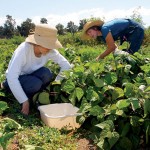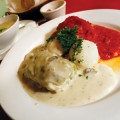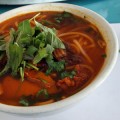Poland, in winter, under the Communist regime of the 1980s, was an unlikely study-abroad location. With my Polish heritage only three generations old, and a sense of adventure, I signed up for four months in Poland.
Poles love food. Bread. Mushrooms. Cabbages, potatoes and beets. These ingredients capture the imagination east of Germany, north of the Tatry mountains and through the plains into Russia. Each region has its own specialties, like sausage in German, duck in Warsaw, fish from Gdansk or sashlik in Lithuania.
In the late ‘80s, the Soviet Union was a crumbling juggernaut. In Poland, meat rationing was still prevalent. As a student, I was allocated a monthly standard ration of 2 kilograms of bones, 250 grams of beef and assorted amounts of stomach, tendon and other parts. As a good Pole, I subverted the hated Soviet system and sold my ration card on the black market.
Bones make soup, and soup is the soul of Polish cooking. It comes in two categories: clear meat-based simmers including cabbages and beets, or mushroom soup with a cream base. A cabbage or beet soup should have a rich hearty core and mouth feel but no obvious meat, with a depth imparted by a healthy fat content, as when a home cook would use the ration’s quota of bones. In summer, the soup can be lighter, allowing freshness of the vegetables to shine through. In winter, the silky feel of fat predominates.
Growing up, I ate standard American fare, except for Christmas dinner. Although our household was nonreligious, the Catholic feast of seven fishes was enthusiastically observed. The table would groan with a dozen dishes, but to honor the fast before Christmas, no meat was served. In my grandparent’s house, the centerpiece fish was always a lightly breaded and baked cod or haddock. The first course of the festivities was always beet soup, made meatless to fit the holiday.
Instead of a clear, sweet soup with a hint of fat, our Christmas beet soup has the zing of a Chinese hot-and-sour. To replace the richness of fat, the greens of the beet are sauteed first, then the grated beets and water are added to simmer. Several tablespoons of peppercorns are featured, along with a healthy serving of vinegar. The vinegar must be added late, so the bite remains in the bowl.
A lovely regional specialty is zurek, often translated as fermented rye soup, or listed as “sourdough soup” at Bona Restaurant in Menlo Park. Zurek is a specialty of Wielka Polska—Old Poland—the area between Warsaw and Berlin where the first kings of Poland were crowned, central to the rolling farmland stretching from Amsterdam to Moscow.
Zurek is fermented rye, first soaked then hung in a bag until the mash becomes naturally fermented and slightly sour. The soup is lightly cream based—not as heavy as a mushroom soup nor a winter beet soup. The slightly sour taste, in moderation with the cream, creates an interest that should dance in the mouth. Similar to our Christmas beet soup, sour adds interest and punch.
Two restaurants in the South Bay feature eastern European soups. Bona Restaurant in Menlo Park serves a delightful collection of Polish soups, including zurek and an astonishing mushroom soup. Zurek is rare; I ate it in Poland, at now-defunct Old Warsaw in San Francisco, and now at Bona. It’s a soup structured to surprise and delight, and worth the trip.
Russian Cafe and Deli in Campbell, is a little south bay gem. A selection of vodka lines an entire wall. The shop has a small seating area, so take-out might be well advised. The style of beet soup ($6.99) hails from the Ukraine and Russia, where soups are sweeter and uncomplicated. Good ingredients are grated and simmered, and the requisite dollop of sour cream must be added to create the necessary complexity. Russian Deli’s offering is bright and fresh, but my taste prefers the Polish style.
In the best tradition of South Bay dining, several hidden gems highlight an entire region’s complexity. Stop by and try the soup.

 Motorcycle Show Displays Wide Array of Two Wheeled Machines
Motorcycle Show Displays Wide Array of Two Wheeled Machines  Live Feed: Giving Thanks
Live Feed: Giving Thanks 


